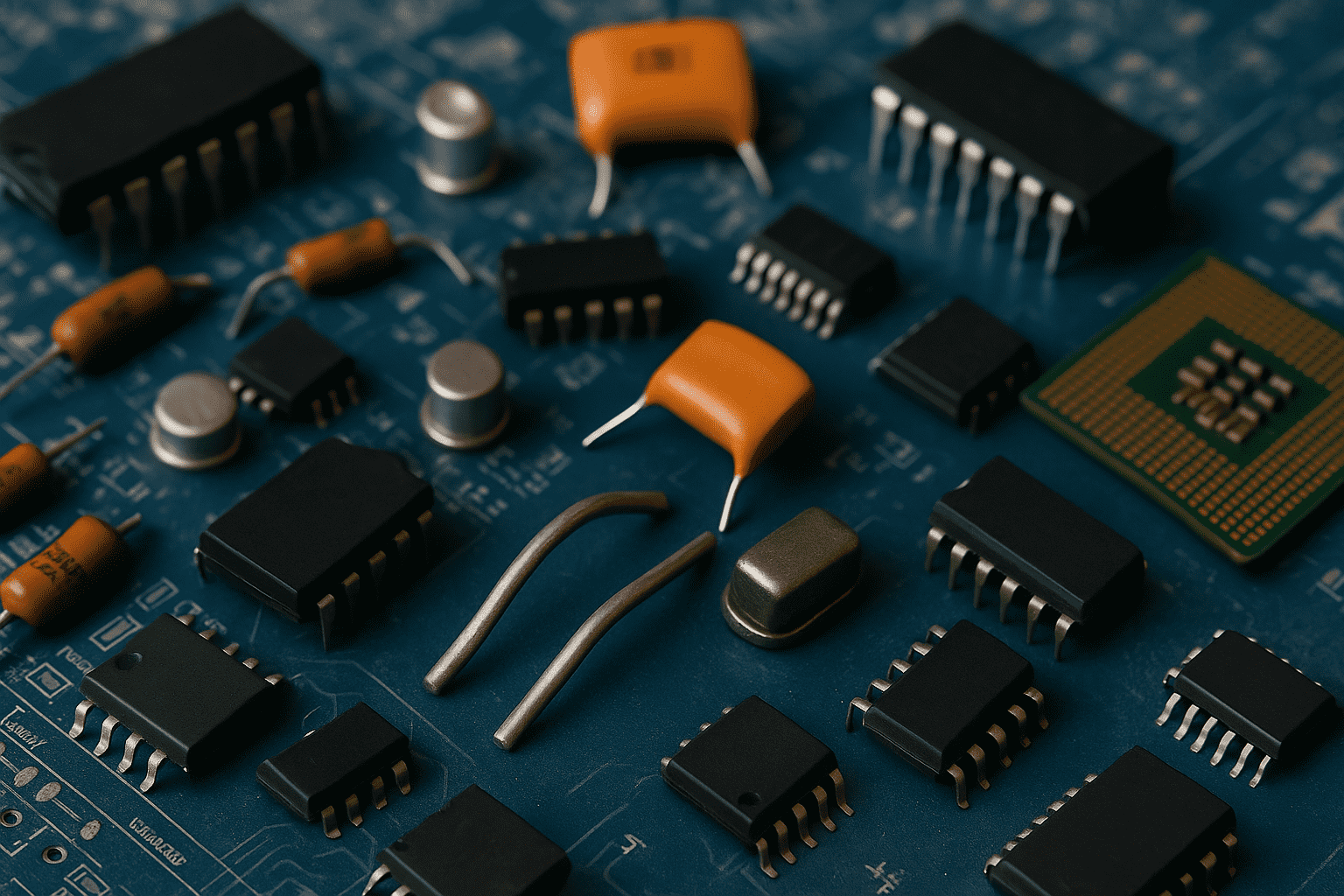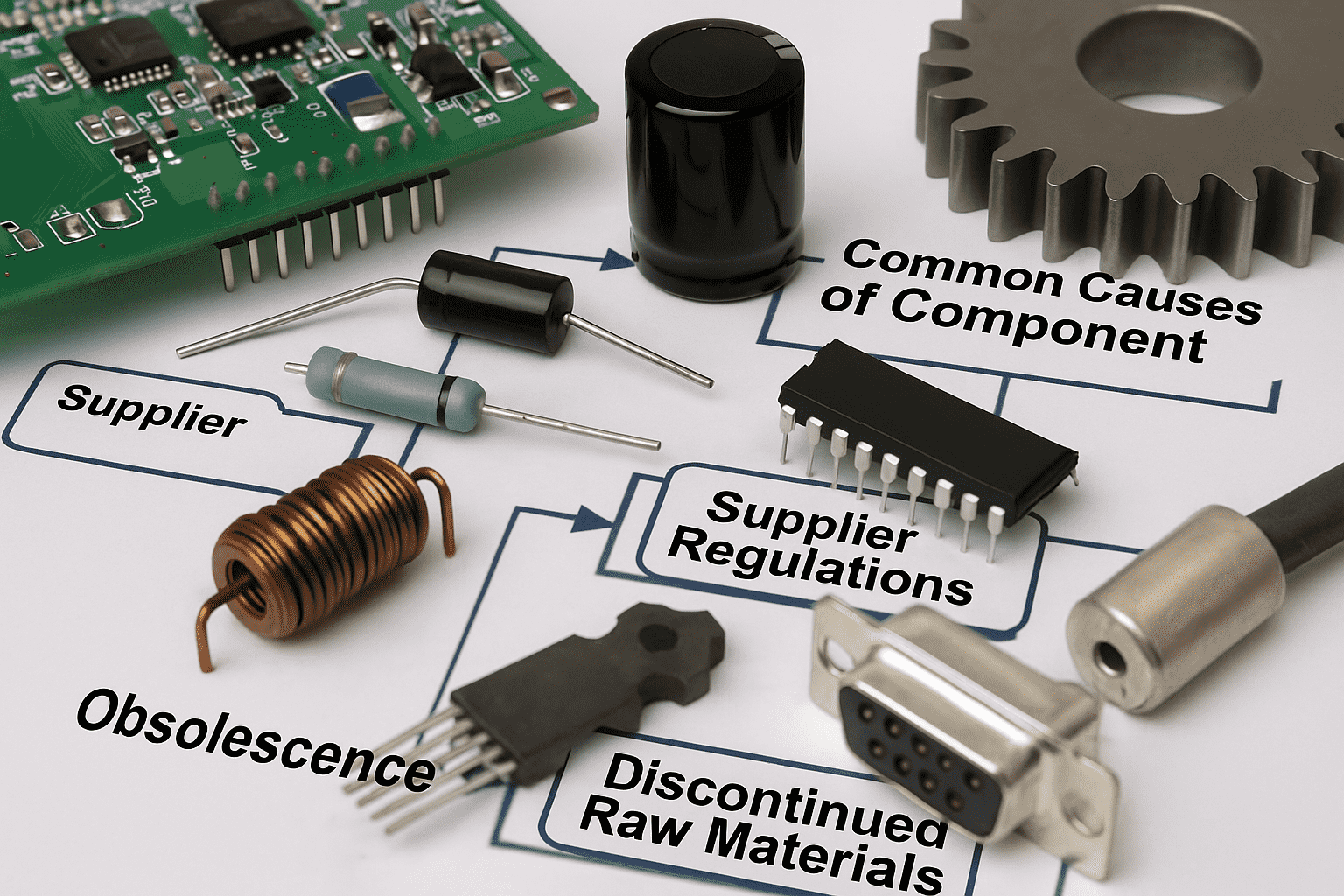Component Obsolescence: What It Is & How to Manage It

Component obsolescence occurs when critical parts become outdated, discontinued, or no longer available. This challenge is more than an operational nuisance; it can act as a financial threat.
The rapid pace of technological change, shifting market demands, and frequent supplier exits are accelerating the risk of obsolescence across industrial supply chains.
Research from the University of Maryland’s Center for Advanced Life-Cycle Engineering (CALCE) shows that unplanned redesigns, last-time buys, and premium sourcing tied to component obsolescence add about $7 billion in extra costs to U.S. manufacturers every year.
In this blog, you’ll learn the key causes of component obsolescence and explore practical strategies to proactively manage and mitigate obsolescence risks in your supply chain.
What Is Component Obsolescence?

Component obsolescence occurs when critical parts become outdated, discontinued, or unavailable before the products or systems they support reach their end-of-life.
Unlike general inventory obsolescence, which involves entire products becoming obsolete, component obsolescence specifically affects individual parts that are essential for ongoing manufacturing, maintenance, or repair. These parts become short in supply and unavailable, disrupting operations and increasing the challenge of maintaining production and service continuity.
Common examples include like semiconductors and microchips, maintenance, repair, and operations (MRO) spare parts, and specialty components designed for industrial machinery or process lines.
Common Causes of Component Obsolescence

Component obsolescence can arise from several factors that impact manufacturing and supply chain operations. The pace of change and evolving market dynamics often leave businesses with limited control over when and how parts become obsolete. Identifying these causes early and planning accordingly is crucial to maintaining continuity and minimizing costs.
1. Rapid Technology Advancement
As new technologies emerge, older components quickly become outdated. Manufacturers may introduce faster, more efficient alternatives, leaving older parts behind. In industries like electronics, automotive, and manufacturing, this continuous innovation cycle can render once-critical components obsolete almost overnight, disrupting production lines and increasing costs for businesses.
2. Supplier Consolidation or Market Exits
Supplier consolidation and market exits can significantly impact component availability. When suppliers merge or exit the market, the parts they previously provided may become scarce or entirely unavailable. This leaves manufacturers scrambling to find replacements, often at higher costs or with longer lead times. For industries reliant on specialized components, supplier shifts can trigger sudden obsolescence, forcing businesses to adjust quickly or face disruptions in production.
3. Shrinking Demand and Minimum Order Quantities (MOQs)
As market demand for certain components shrinks, suppliers may stop manufacturing or supporting those parts, especially if they are unable to meet minimum order quantities (MOQs). When demand decreases, businesses are left with the challenge of securing obsolete components for continued production. Additionally, smaller orders become economically unfeasible for suppliers, leading to discontinued parts and decreased procurement efficiency. This can result in costly last-time buys or force businesses to seek alternative components that may not meet the same specifications.
4. Changes in Standards or Regulations
Changes in industry standards or regulations can render certain components obsolete, even if they were previously in high demand. New safety, environmental, or quality standards may require businesses to replace existing parts with compliant alternatives. For example, stricter emissions regulations in the automotive industry or new environmental guidelines in electronics manufacturing can quickly phase out components that do not meet the updated criteria. These regulatory shifts require businesses to adapt swiftly, often resulting in additional costs and project delays as they work to comply.
5. Discontinued Raw Materials
The discontinuation of raw materials can lead to component obsolescence, particularly when these materials are essential to the production of specialized parts. If a supplier stops producing a specific raw material or changes its specifications, manufacturers are left with limited options to maintain production. This can result in the need for costly material substitutions, redesigns, or new sourcing strategies, impacting both production timelines and costs.
Our Success Story: How Amplio Helped Hayden AI Navigate Component Obsolescence
Strategies to Manage and Mitigate Component Obsolescence

Effectively managing component obsolescence requires a proactive approach, combining forward-thinking strategies and robust processes. Here are a few strategies that help mitigate the impact of obsolescence while safeguarding both operations and profitability.
1. Lifecycle Planning & Forecasting
Implementing predictive analytics for demand and supply forecasting enables businesses to anticipate when components may become obsolete. By integrating lifecycle status into procurement and design, you can better plan for part replacements and reduce the risk of unexpected shortages or delays.
Monitoring the full lifecycle of components ensures timely interventions, whether it’s securing last-time buys or switching to more sustainable alternatives before obsolescence strikes.
2. Approved Alternatives
To mitigate the risk of obsolescence, it’s crucial to pre-qualify substitute parts that can seamlessly replace components no longer produced by manufacturers. By maintaining a list of approved alternatives within your Bill of Materials (BOM) software, you can ensure that when a critical part becomes unavailable, you can quickly transition to a viable replacement without disrupting operations.
BOM tools provide visibility into your parts inventory, helping track and manage these alternatives efficiently. Pre-qualifying these substitutes through rigorous testing and validation ensures they meet the necessary performance and compliance standards, facilitating a smooth transition and reducing reliance on hard-to-find components.
3. Supplier Collaboration & Roadmap Transparency
Collaborating closely with suppliers provides invaluable visibility into their product roadmaps, including phase-out schedules and upcoming changes. By engaging suppliers early in the process, you can secure extended support or negotiate transition periods to allow ample time for sourcing alternatives.
Transparent communication ensures that you can proactively manage component obsolescence, reducing the risk of sudden disruptions and providing sufficient lead time to make necessary adjustments to your supply chain. This proactive approach strengthens supplier relationships and minimizes the financial impact of obsolescence.
4. Using Circular Economy Channels as Second Sourcing Options
When facing component obsolescence, leveraging circular economy channels for second sourcing is a highly effective strategy. By sourcing components from surplus inventory, remanufacturers, or trusted secondary markets, you can access parts that are no longer available through traditional suppliers.
Partnering with industrial liquidators and circular economy networks allows you to tap into a wide pool of surplus parts and materials, reducing reliance on primary sources and mitigating the risks associated with obsolescence. This approach not only helps secure hard-to-find components but also supports sustainability by reusing and recycling materials that would otherwise be discarded.
How Amplio Helps You Navigate Component Obsolescence

1. Real-Time Inventory Monitoring
Amplio’s AI-powered inventory analysis tool offers real-time visibility across multiple facilities. It matches surplus and similar parts, making it easier to facilitate internal transfers and reduce procurement costs, streamlining your inventory management.
2. Access to a Network of Surplus and Vetted Industrial Sellers
Gain access to a trusted network of industrial buyers and sellers, enabling you to source hard-to-find components and excess inventory, reducing the need for expensive last-minute purchases to overcome component obsolescence.
3. Expert Support for Risk Assessment, Transition Planning, and Last-Time Buys
Amplio provides expert guidance to assess obsolescence risks, plan transitions, and secure last-time buys, ensuring continuity and minimizing disruptions in your supply chain.
Contact us now and let us help you optimize your supply chain and ensure smooth operations.